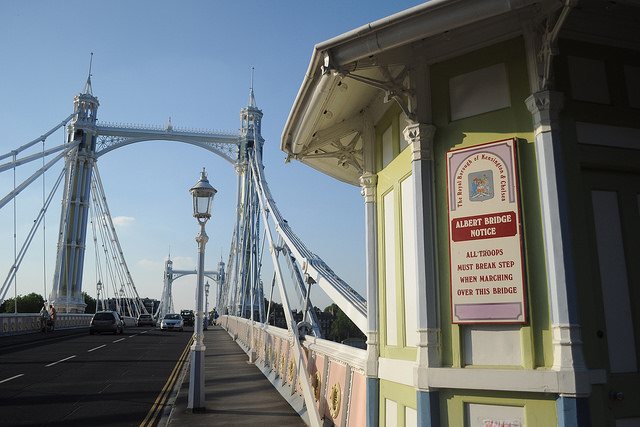Marching Forward and Tumbling Down
Imagine a small group of military members, lined up four across, marching. You probably are now picturing two additional details; first, they’re likely chanting some sort of military cadence, and second, they’re likely moving in lockstep — when one person takes a step with his or her left leg, so do the other members of the group. That second thing is called military step, and it’s typically required — except when going over suspension bridges.
In that case? Lockstep marching is a really bad idea.
Let’s start with a photo.

That photo (via flickr) is of the Albert Bridge, which crosses the Thames in London. If you can’t read the sign, it says that “all troops must break step when marching over this bridge.” In other words, troops can’t stay in sync — they need to mix it up a bit.
The reason isn’t some weird antipathy toward the military, a dislike of parades, or a preference of chaos over order. It’s science — and ultimately, safety. The culprit? As LiveScience explains, “structures like bridges and buildings, although they appear to be solid and immovable, have a natural frequency of vibration within them.” That’s usually not a problem, as the architects and engineers factor those vibrations into account. But what happens when something comes along that adds more vibrations at the same frequency? In that case, something called “mechanical resonance” kicks in. LiveScience continues: in those cases, “[the] force that’s applied to an object at the same frequency as the object’s natural frequency will amplify the vibration of the object.”
And too much amplification is bad news, as most buildings aren’t designed to account for that. For some — like suspension bridges — the results can be particularly dangerous. Unfortunately, that lesson was learned the hard way.
On April 21, 1831, a detachment of 74 British soldiers stationed in the town of Salford, Greater Manchester, were marching back home over the Broughton Suspension Bridge, which at the time was only five years old. They never made it across. Wikipedia summarizes what went wrong:
The soldiers, who were marching four abreast, felt it begin to vibrate in time with their footsteps. Finding the vibration a pleasant sensation some of them started to whistle a marching tune, and to “humor it by the manner in which they stepped”, causing the bridge to vibrate even more. The head of the column had almost reached the [other] side when they heard “a sound resembling an irregular discharge of firearm.” Immediately, one of the iron columns supporting the suspension chains on the [first] side of the river fell towards the bridge, carrying with it a large stone from the pier to which it had been bolted. The corner of the bridge, no longer supported, then fell 16 or 18 feet (4.9 or 5.5 m) into the river, throwing about 40 of the soldiers into the water or against the chains.
Thankfully, none of the men died — the relatively shallow water meant a lot of broken bones and concussions, but no drownings. (That said, another bridge collapse — in France in 1850 — resulted in over 200 deaths, although corrosion, stress from a recent storm, and having too many troops on it at once may have contributed more to the tragedy than some coincidental harmonics.) And also thankfully, the architects at the time were able to identify mechanical resonance as the culprit.
As a result, you’ll rarely see troops march over bridges in step. The Albert Bridge makes sure of that with its signs, but it doesn’t really have to worry anymore — its nearby barracks closed in 2008.
Bonus fact: London Bridge — not to be confused with London’s much cooler-looking Tower Bridge — also crosses the Thames. But you don’t have to go to London to see it. Well, you do to see the current one, but if one of its predecessors is good enough, you can go to Arizona. In 1967, the old London Bridge needed to be replaced, so the city of London decided to list it for sale. An American entrepreneur named Robert McCulloch bought the bridge for about $2.5 million and had it shipped, piece by numbered piece, to Arizona, where he used it as a centerpiece for a planned community he was developing. The ploy worked; as Wikipedia notes, “after the bridge was reconstructed, prospective buyers of land were attracted to visit the bridge and take a tour of properties for sale. Land sales improved, and McCulloch recouped all his expenses on the purchase and shipping of the bridge.”
From the Archives: The Power to Move You: How a tae bo class (plus some mechanical resonance) created what many thought was an earthquake. (It wasn’t.)
Related: London’s Tower Bridge, in a form that makes it fun (kinda) if it falls down.
